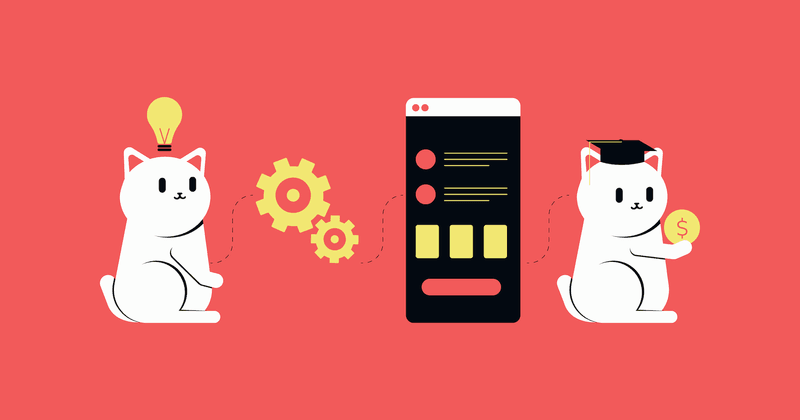Building mobile apps as side projects for fun, learning, and profit
Why app side projects are a win for everyone

Stuart is a co-founder and co-CEO of Appbot, the leading reviews and ratings platform, empowering 35% of the world’s top-charting apps to efficiently monitor and respond to mobile app reviews and ratings. With a track record of success, Stuart has developed mobile apps downloaded by over 10 million users, including WordBoard Keyboard, 7 Minute Workout, and Discovr Music.
I’ve long been a big believer in side projects both back when I was an employee through to now as a founder. They can be a lot of fun — you can learn a lot to help you in your day job and maybe even make a bit of money on the side.
At Appbot we encourage side projects. There have been some big wins for us from team members who have learned new technologies, scratched an itch, or generated some content that’s been helpful to Appbot’s growth.
I’ve managed to get millions of downloads and over a million USD of revenue from my side projects.

This article aims to convince you, whether you are an employer or employee, that side projects are a win for everyone.
Why start a side project?
There’s so many reasons why you might want to start a side project, including:
- You want to try out a new technology
- There’s an idea you just can’t let go of
- You want to make a bit of money on the side
- You want to broaden your skill set (for example you’re a designer who wants to learn to code or vice versa)
- The list goes on
I have two mobile apps I maintain to this day and they were born for very different reasons.
7 Minute Workout was born because I wanted to run an experiment. Could I build an app, iterate, and build a story around it? It ended up getting millions of downloads, got acquired, given back to me and generated some content that was read by hundreds of thousands of people and helped propel Appbot in the early days.
I created WordBoard to scratch an itch. Apple had just announced custom keyboards for iOS and I was frustrated that I couldn’t easily re-use phrases and text. WordBoard has been a long slow burn, but has actually ended up being more successful than 7 Minute Workout. More on that later.
Why a mobile app?
Opting for a mobile app as a side project offers a compelling blend of accessibility to tools and education, opportunity and maintainability. Nearly everyone owns a smartphone today, making mobile apps incredibly relevant to a wide audience. This universality means whatever you create, be it a game, a tool, or something totally from left field, it has the potential to resonate with a wide audience.
Distribution is taken care of for you by the app stores and they can also potentially do a lot of your marketing. The built in payment tools and workflows simplify the maintenance greatly, we will dig into this in more detail later.
The one big thing I love about mobile apps is that, if you choose the right idea, you might not even need a server. It can be completely self contained. No downtime, no servers to maintain, no fixes in the middle of the night!
Thus, mobile apps make a great choice for side projects.
Choosing the right project
There’s a few criteria I like to check off for a side project:
- Is this something I’m actually interested enough in to keep at it for years?
- Is anyone else likely to want this app?
- Can I make version 1 in a reasonable time frame?
- Can it exist for months on end without any intervention from me?
- Is there a popular trend or technology to leverage at launch?
As I mentioned above, the 7 Minute Workout app was built as an experiment, but the idea still needed to be chosen. At the time the 7 Minute Workout was buzzing around the New York Times and Hacker News. I was actively doing the workout every day and wanted a simple timer and instructions rather than following some pictures. It was something I could build quickly and easily.
WordBoard jumped on a new technology from Apple, third party keyboards. New iOS versions and new technology can be a great way to try and get featured on the App Store. Turns out I didn’t get featured at all, and the launch was slow, but WordBoard has grown over time with a loyal user base. I also had a bit of time off to kill and decided to spend a couple of weeks getting the app out of the door.
Often the best ideas are the most obvious ones. The ones that just keep whirling around in your head that you can’t forget about.
Planning and development
Break down your big app dream into smaller, bite-sized pieces. I find a good way to think about it is, what’s the minimal thing you can ship that you would tell your friends about? What can you live without in V1? This way, you can celebrate the small wins, keep your motivation tank full, and, more importantly, make sure you’re always on the right path. It’s about making a map for your app journey, so you don’t end up lost in the woods.
On one side, you’ve got your vision of the perfect app, all shiny and flawless. On the other, the real world, with its annoying limits like time, money, and your sanity. Here’s where you’ve gotta be a bit of a tightrope walker. Aim for high quality, sure, but don’t get so obsessed that you never launch. Sometimes, ‘good enough’ is your best friend. And hey, why not let generative AI chip in? It’s like having a super-smart buddy who’s great at speeding up tasks. Use it to tackle the heavy lifting, from coding to content, so you can keep things moving without compromising too much.
Remember, the goal is to launch an app that you’re proud of, without burning out or breaking the bank.
Making an iOS app is easier than ever. Swift UI is a great platform to make apps compared to the past, you can get so much UI up and going with very little code. Apple also provides Swift Playgrounds to learn Swift and Swift UI, I highly recommend giving it a go.
Monetizing your app
This is one place where I think mobile apps really shine for side projects. There has been a lot of talk about Apple’s 30% cut, much of it negative. Luckily, for smaller companies that make less than $1m USD a year it’s cut to 15% thanks to Apple’s Small Business Program. Either way, in my opinion it’s an absolute bargain for side projects. Apple takes care of trials, credit cards, retrying, dunning, refunds, renewals, exchange rates, tax … the works. As someone who runs a SaaS company by day, believe me, that is a lot of time, money and effort to implement and maintain. I get why companies that have to implement that anyway don’t like paying the 30% cut, but for side projects I’d take it any time.
Subscriptions are where most apps end up landing for monetization. I also include a lifetime option (one time purchase) as it was requested a lot on support tickets.

Subscriptions totally turned around the monetization of my app WordBoard.

Services like RevenueCat make it easy to implement subscriptions across platforms and see your MRR and subscribers across platforms and multiple apps.
Here’s how my RevenueCat Dashboard looks for WordBoard and 7 Minute Workout.

Maintaining the app
While launching v1 of your app is a big win, you’re probably still right at the beginning of your journey. You’re probably going to want to iterate on it at least a bit to try and get some users. But what do you do long term? There’s support tickets, app reviews, iOS updates, bugs etc.
Here’s my setup:
- For support I use HelpScout with their knowledge base. Every time a support question comes up multiple times, I add an article. I end up with 3 or 4 support tickets a month. Great value for $20 / month.
- For app reviews I use AI auto replying for 4 and 5 stars (I get bored of saying thanks in 20 different ways and other languages) and route 1, 2 and 3 star reviews into HelpScout where I can reply to them directly as if they are a normal support ticket.
- Whenever a new iOS version is nearing the end of the beta, I make sure I give the app a quick test. Once the GM is out, I build the app for the new iOS version and submit it to App Store Connect.
- TestFlight is your friend. Get a bunch of testers on your list.
Give it time
Success can take time and iterations. One of the advantages of a side project is there is less pressure to make it fly on a time frame (without it having to support you financially) compared to a startup or day job.
7 Minute Workout growth
7 Minute Workout had a huge launch as far as downloads go. Over 300k one week. But it has declined over time.

The sales don’t line up the same. How you monetize your app, and the type of downloads you get are extremely important.

You can see the early downloads didn’t lead to much revenue. But after I reacquired the app and updated it I managed to get some reasonable revenue for the much lower download numbers.
WordBoard growth
WordBoard is a different story. It did have a relatively good launch, but nowhere near the numbers of 7 Minute Workout. Downloads have held pretty steady over time.

But the sales are a very different story. Users loved WordBoard, but I wasn’t charging enough. Increasing the price and introducing subscriptions changed it completely.

Conclusion
Developing mobile apps as side projects is a journey that blends learning, innovation, and potential financial rewards. My experiences with the relative success of apps like WordBoard Keyboard and 7 Minute Workout show the benefits side projects can bring. Side projects also serve as a great tool for professional growth, allowing you to experiment with new technologies, bring ideas to life, and perhaps most importantly, contribute significantly to your personal and professional development.
My decision to focus on mobile apps was strategic, driven by the accessibility of the tools, the extensive reach of smartphone ownership, and the supportive infrastructure of app stores. Mobile apps can thrive with minimal maintenance and in some cases, operate without the need for servers.
My journey through the development and monetization of apps underscores the multifaceted rewards of such endeavors, from the satisfaction of solving user problems to the tangible benefits of revenue generation. I hope I have convinced you to get it a shot.
Best of luck with your apps!
You might also like
- Blog post
Scaling UA without wrecking your conversion rate: A Meta campaign playbook
A structured testing system helped one app lower cost-per-trial while targeting its most profitable users
- Blog post
Gamification in apps: A complete guide to using motivation to drive real value
Why streaks fall short and 11 apps getting gamification right
- Blog post
Apple’s June 2025 EU update: one entitlement, three fees, and CTF’s 2026 sunset
What apps in the EU should do after Apple’s DMA tweak.

